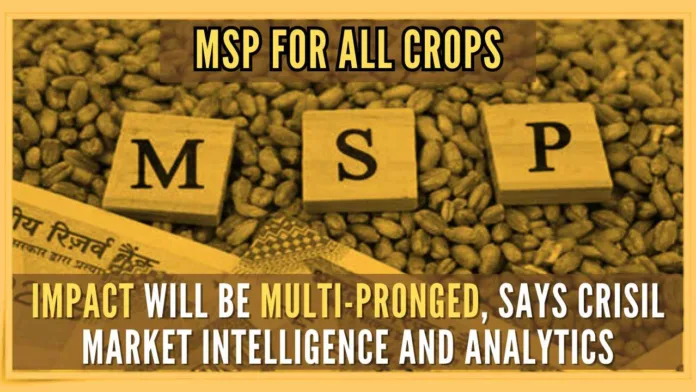
Guaranteeing MSP across crops will lead to the percolation of the benefit across the country
It will be a multi-pronged impact if the government decides to procure the entire production of 23 crops for which minimum support price (MSP) has been announced, said an official of CRISIL Market Intelligence and Analytics.
For the exchequer, this will mean a higher outgo and for the farmers growing certain crops, it would mean cash support during times when prices plummet below MSP.
It will also give them the freedom to sow crops of their choice and be more amenable to their local conditions, said Pushan Sharma, Director-Research, CRISIL Market Intelligence & Analytics. “Considering the government will procure only crops trading in mandis below the MSP, our calculations show it will need a working capital of approximately Rs 6 lakh crore in Marketing Year (MY) 2023. We considered 16 of 23 crops, which account for over 90 percent production of the field crops, for the analysis,” Sharma said.
The real cost to the government, though, will be the difference between MSP and mandi prices, which works out to around Rs.21,000 crore for MY2023.
The cost could be higher if the government offloads the commodities in mandis because then prices could fall further than what was seen in those markets in 2022-23, which was used to calculate the government’s bill, Sharma said.
Of the 16 crops tracked, eight traded higher than MSP and hence would not require procurement; the cost estimations reflect procurement for the remaining eight crops that traded below MSP.
According to Sharma, while MSP is announced for 23 crops, the government ends up meaningfully procuring only two crops — paddy and wheat — and hence over 60 percent of field crop production in
India comes from only these two crops (excluding sugarcane) as farmers tend to opt for these given the MSP support and lack of risk appetite for other crops.
Sharma said a look at Kharif 2022 and Rabi 2023 shows that 41 percent of the paddy and 24 percent of the wheat produced during the year was procured. Next came mustard, where 9 percent of production was procured.
Eight crops did not need procurement at MSP as their mandi prices were higher. For the remaining 5 crops, procurement was less than 3 percent of the production.
In this milieu, guaranteeing MSP for all crops can lead to farmers moving to crops other than paddy and wheat, which see the maximum procurement.
Another critical aspect to consider is that procurement is concentrated in only a few states, such as Punjab, Haryana, Madhya Pradesh, Chhattisgarh, Telangana, and Uttar Pradesh, so farmers in other states do not get the benefit of MSP.
Hence, guaranteeing MSP across crops will lead to the percolation of the benefit across the country.
It will support farmer income and thereby also give a push to consumption demand. On the inflationary side, though, a few crops could see an up move in prices if the mandi prices are much lower than MSP.
[With Inputs from IANS]
For all the latest updates, download PGurus App.
- BJP drops 2-term sitting MP Poonam Mahajan; fields 26/11 counsel Ujjwal Nikam from Mumbai North Central - April 27, 2024
- RBI sets criteria for Small Finance Banks seeking Universal Banks license - April 27, 2024
- 16 Indian crew members on seized cargo ship to be released soon: Iran Foreign Minister - April 27, 2024










